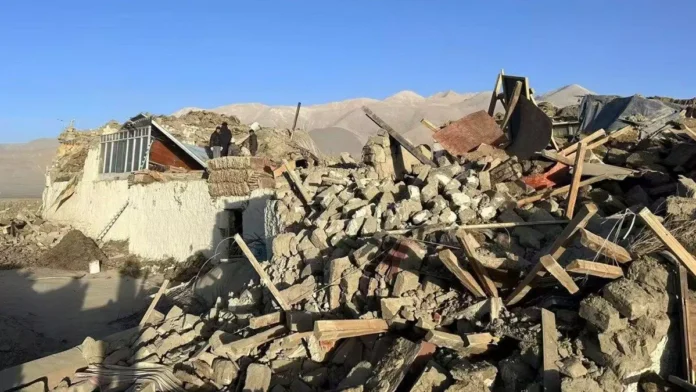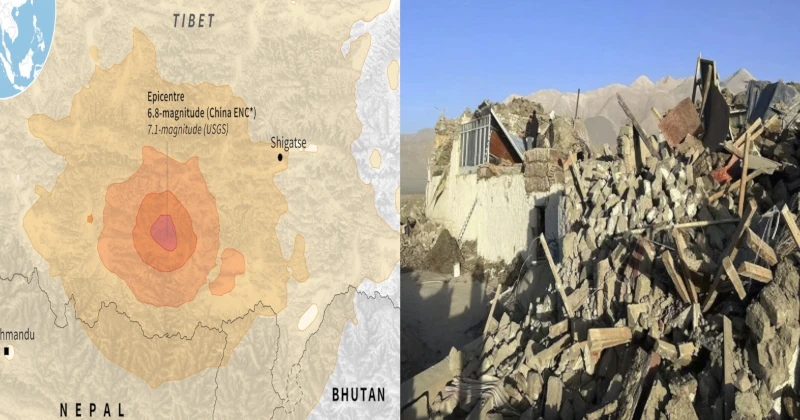A 7.1 Magnitude Earthquake hit Tibet earlier today, causing widespread tremors that were felt across several regions of India, including Delhi-NCR, Bihar, West Bengal, and Assam. Neighboring countries like Nepal, Bhutan, and Bangladesh also reported the effects of the seismic activity. The powerful earthquake has raised concerns about potential damage and casualties, though official assessments are still underway.
What Happened in Tibet?
The 7.1 Magnitude Earthquake originated in the Tibetan plateau, a region known for its seismic activity due to the collision of the Indian and Eurasian tectonic plates. The earthquake struck in the early hours, registering a high intensity on the Richter scale. Its epicenter was reported to be near the border of Tibet and Nepal, making it a significant seismic event for South Asia.
This earthquake, with its shallow depth of origin, had a more pronounced impact on the surface. Tremors lasted for several seconds, rattling buildings and causing panic among residents. The tremors were particularly intense in Tibet, a region that has historically experienced some of the strongest earthquakes in the world.
Impact on India
The tremors from the 7.1 Magnitude Earthquake were felt across northern and eastern India. In Delhi-NCR, residents reported shaking buildings and swaying furniture. People rushed out of their homes and offices as precautionary measures. Bihar and West Bengal also witnessed similar panic, with reports of mild structural damages in some areas.
In Assam, the tremors caused disruptions in daily life, particularly in regions closer to the Indo-Tibetan border. Seismologists have warned that aftershocks may follow, urging residents in these regions to remain vigilant. Emergency response teams are on standby, although no significant damages or casualties have been reported in India as of now.
Tectonic Activity in the Region
The 7.1 Magnitude Earthquake is a stark reminder of the Himalayan region’s vulnerability to seismic events. The Indian tectonic plate’s constant movement toward the Eurasian plate creates immense pressure, resulting in frequent earthquakes. This geological phenomenon has made countries like India, Nepal, and Bhutan highly susceptible to seismic disasters.
Historically, this region has witnessed catastrophic earthquakes. The 2015 Nepal earthquake, for instance, claimed over 9,000 lives and caused massive destruction. Similarly, Tibet has experienced several high-magnitude earthquakes, given its proximity to the active tectonic fault lines.
Preparedness and Challenges
In regions prone to earthquakes, preparedness is key to minimizing damage and loss of life. However, challenges remain, especially in densely populated areas like Delhi-NCR. Urban development often ignores seismic safety guidelines, leaving buildings and infrastructure vulnerable to collapse.
After the 7.1 Magnitude Earthquake, experts have reiterated the importance of stricter building codes and regular seismic assessments. Governments in India and neighboring countries are being urged to invest in earthquake-resistant infrastructure and public awareness campaigns.
The Role of Technology in Monitoring Earthquakes
Modern technology has played a crucial role in detecting and analyzing seismic activity. Advanced seismographs and GPS systems were able to record the 7.1 Magnitude Earthquake in real time, providing valuable data to scientists. Mobile applications and alert systems are also being developed to warn people of impending earthquakes.
However, the effectiveness of these systems depends on timely action and public cooperation. The lack of a robust early warning system in South Asia remains a concern, especially for countries like India, which are frequently affected by earthquakes.
Historical Context of Earthquakes in Tibet
Tibet has a long history of powerful earthquakes due to its geographical location. The 1950 Assam-Tibet earthquake, for example, was one of the strongest recorded in the region, with a magnitude of 8.6. It caused widespread destruction and claimed thousands of lives. Similarly, the 2008 Sichuan earthquake in neighboring China highlighted the devastating impact of seismic events in mountainous regions.
These historical events underscore the need for better disaster management strategies. Lessons from the past can guide future efforts to mitigate the impact of earthquakes in Tibet and its surrounding areas.
International Response to the Disaster
The international community has expressed concern over the 7.1 Magnitude Earthquake and its potential impact on Tibet and neighboring countries. Aid organizations are monitoring the situation closely, ready to provide assistance if needed. Neighboring countries like India and Nepal have also offered support, showcasing regional solidarity in times of crisis.
Efforts to strengthen regional cooperation in disaster management are ongoing. Joint training exercises and information-sharing initiatives have been proposed to improve preparedness and response in the event of major earthquakes.
What Lies Ahead?
As the region recovers from the 7.1 Magnitude Earthquake, attention will shift to assessing the full extent of its impact. Immediate priorities include providing aid to affected communities, repairing damaged infrastructure, and monitoring aftershocks. Experts have also called for a long-term approach to earthquake preparedness, emphasizing the importance of resilience in the face of natural disasters.
For the residents of Tibet and other affected areas, the earthquake serves as a grim reminder of the region’s vulnerability. Yet, it also highlights the resilience and adaptability of communities in the face of adversity.




